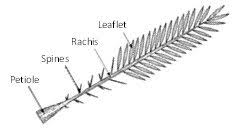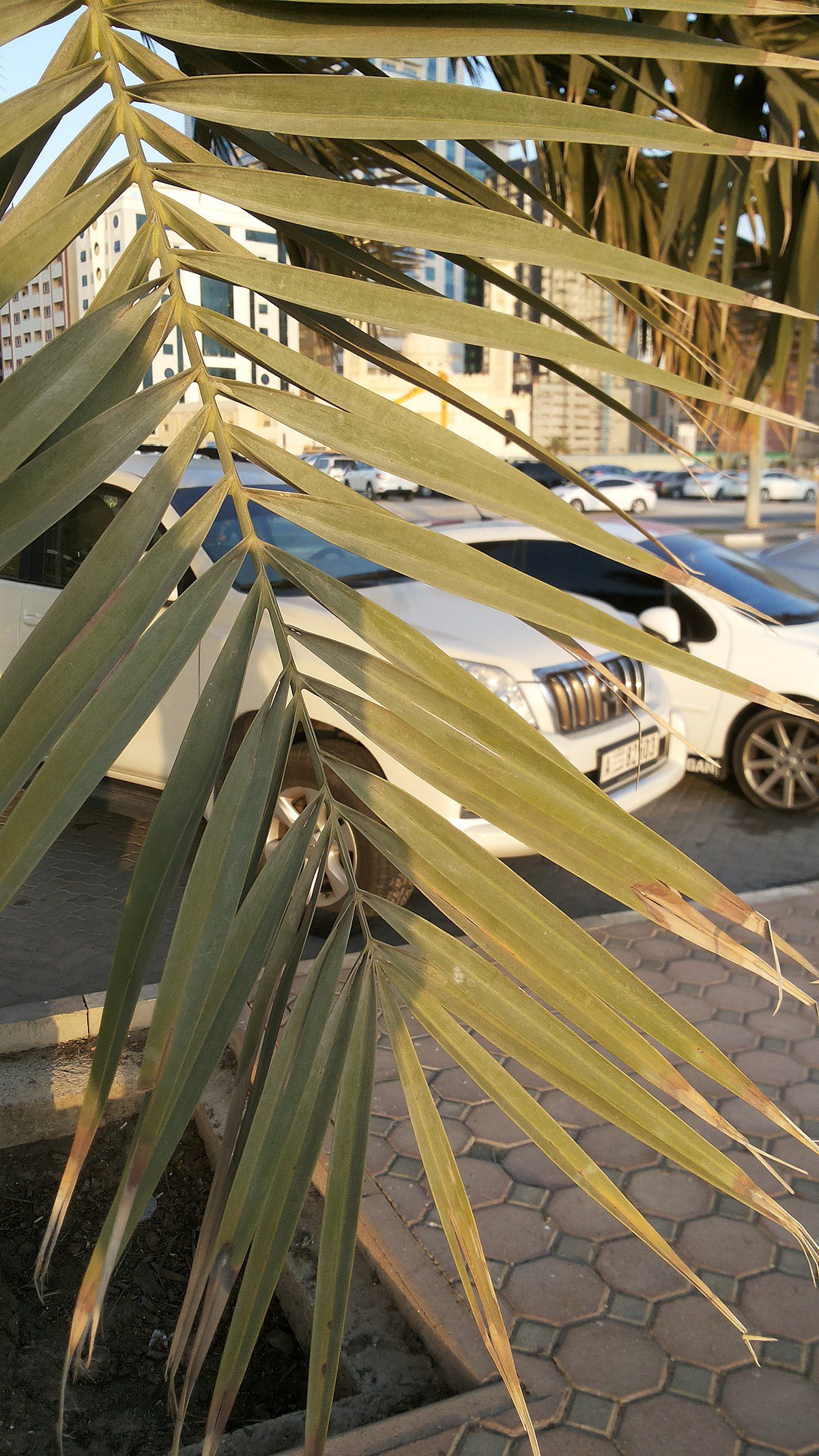Dates leaflets are the individual segments or parts that make up the compound leaves of the date palm tree. They are typically elongated and lance-shaped, resembling a feather or a feather-like structure. Each leaflet is attached to a central stem known as the rachis. Dates leaflets are arranged in a pinnate pattern, meaning they are attached to the central rachis in a feather-like arrangement, similar to the structure of a feather.
The size of date palm leaflets can vary depending on the age and health of the tree. Generally, they can range from a few inches to several feet in length. Mature date palm trees may have longer and wider leaflets compared to young trees. Date palm leaflets are typically green, although the exact shade of green can vary from tree to tree and can be influenced by factors such as sunlight exposure and nutrient levels.
The texture of date palm leaflets is smooth and generally has a glossy appearance. They are thin and flexible, making them well-suited to swaying in the wind. Date palm leaflets usually have serrated or toothed edges, which can vary in sharpness depending on the variety of date palm.
Dates leaflets play a crucial role in photosynthesis, where they capture sunlight and convert it into energy for the tree. They also help in transpiration, the process by which the tree releases excess water vapor into the atmosphere. Date palm leaflets are not permanent structures and have a finite lifespan. They eventually die, turn brown, and fall off the tree. New leaflets continuously replace the old ones.
Dates leaflets have been used by various cultures for centuries. They are often woven into various products, such as baskets, mats, and even roofing material. They are also used for traditional crafts and as decorative elements in some cultures. Dates leaflets are a vital part of the date palm tree, contributing to its growth, survival, and cultural significance.
The Economic Importance and Uses of Dates Leaflets

Date palm leaves have several economic and practical uses in various industries and daily life.
Here are some of the economic importance and uses of date palm leaves:
1. Traditional Roofing Material: Date palm leaves are used in many cultures to create thatched roofs. The leaves are layered and woven together to form a waterproof and insulating roofing material. This practice provides employment opportunities for local craftsmen and can reduce construction costs.
2. Basketry: Date palm leaves are widely used for making baskets, mats, and other woven products. These items have both utilitarian and decorative value and can be sold in local and international markets.
3. Fodder: The leaves can be used as fodder for livestock, particularly in arid regions where other forage options are limited. This can help support the livestock industry and provide sustenance for rural communities.
4. Handicrafts: Date palm leaves are a valuable resource for artisans who create various handicrafts, including hats, fans, and decorative items. These products can be sold to tourists and in local markets, contributing to the handicraft industry’s economic importance.
5. Erosion Control: In regions prone to soil erosion, date palm leaves can be used to construct barriers and windbreaks. This helps protect agricultural land and can improve crop yields, indirectly benefiting the economy.
Read Also: Dates Petioles: Economic Importance, Uses and By-Products
6. Biofuel Production: In recent years, researchers have explored the use of date palm leaves as a potential source of biomass for biofuel production. This could contribute to the renewable energy sector’s growth and reduce dependence on fossil fuels.
7. Traditional Medicine: In some cultures, date palm leaves have been used for their medicinal properties. They are believed to have anti-inflammatory and analgesic effects, and extracts from date palm leaves have been used in traditional remedies.
8. Livelihood Support: The date palm industry, which includes the cultivation and harvesting of date fruits as well as the use of date palm leaves, provides employment opportunities for millions of people worldwide. It supports the livelihoods of farmers, laborers, and artisans involved in various aspects of date palm cultivation and processing.
9. Environmental Benefits: Date palm trees play a role in improving soil fertility and maintaining ecological balance in arid and semi-arid regions. This indirectly supports agriculture and other economic activities in these areas.
10. Cultural and Religious Significance: Date palm leaves hold cultural and religious significance in many societies. They are used in various rituals, ceremonies, and festivals, contributing to the preservation of cultural traditions and attracting tourists.
The Products and By-products That Can Be Derived From Dates Leaflets
Dates leaflets, the individual leaf segments of the date palm tree, can be used in various ways to create products and by-products.
Here are some examples:
1. Crafts and Decorative Items: Dates leaflets are often used in traditional crafts and decorative items. They can be woven or braided to create baskets, mats, fans, and other decorative pieces.
2. Thatching Material: The leaflets are excellent for thatching roofs of huts and shelters in some cultures. They provide natural insulation and protection from the sun.
3. Animal Feed: Dates leaflets can be used as fodder for livestock. They are a good source of fiber and nutrients for animals.
4. Fuel: In some regions, dried date palm leaflets are used as fuel for cooking and heating. They burn well and provide a sustainable source of energy.
5. Biofuel Production: Research has explored the potential of using date palm leaflets to produce biofuels such as bioethanol and biogas. This can be an eco-friendly way to utilize agricultural waste.
Read Also: The Health Benefits of Drinking Ashwagandha Tea
6. Compost and Fertilizer: When composted, date palm leaflets can enrich the soil with organic matter, improving its fertility and structure. They can also be used as mulch to retain moisture in the soil.
7. Medicinal Uses: Some traditional medicine systems use date palm leaflets for their medicinal properties. They are believed to have various health benefits, including as a remedy for digestive issues.
8. Animal Bedding: Shredded or processed date palm leaflets can be used as bedding material for animals, such as horses, providing a comfortable and absorbent surface.
9. Basketry: Date palm leaflets are often used in basket weaving. The strong and flexible nature of the leaflets makes them suitable for creating a variety of basketry products.
10. Handicrafts: Craftsmen and artisans may use date palm leaflets to create a wide range of handicrafts, including hats, bags, and wall hangings.
11. Mulch: Chopped or shredded date palm leaflets can be used as mulch in gardens and agriculture. They help retain moisture, suppress weed growth, and regulate soil temperature.
12. Palm Leaf Fans: Date palm leaflets can be woven into fans, which are commonly used in hot climates to provide relief from the heat.
13. Paper and Cardboard: In some cases, date palm leaflets can be used to make paper and cardboard products. This typically involves a process of pulping and pressing the fibers.
14. Animal Bedding: Shredded date palm leaflets can be used as bedding material for animals. They provide a comfortable and absorbent surface for animals to rest on.
15. Environmental Restoration: Date palm leaflets can be used in environmental restoration projects, such as erosion control and re-vegetation efforts.
In conclusion, it is important to note that the usability and applications of date palm leaflets can vary depending on the region and local traditions. Additionally, the processing methods can differ, resulting in various products and by-products.
Read Also: Comprehensive Farm Startup Guide

